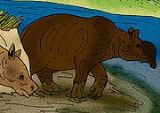
Brachycrus
Encyclopedia
Brachycrus is an extinct genus
of terrestrial
herbivore
of the family
Merycoidodontidae, subfamily Merycochoerinae, (oreodont
) endemic to North America
during the Middle Miocene
to Late Miocene
subepochs (20.6—13.6 mya) existing for approximately .
, but was more specialized. Brachycrus had jaw
s which were short, and because the nostril
s were placed far to the back the creature is presumed to have a tapir
-like proboscis
. Brachycrus was named by Matthew 1901 as a subgenus of Merycochoerus and raised to genus level by Palmer in 1904. It was synonymized subjectively with Ticholeptus by Thorpe (1937). It was assigned to Merycoidodontidae by Palmer (1904), Schultz and Falkenbach (1940), Schultz and Falkenbach (1968), Kelly and Lander (1988) and Lander (1998).
Genus
In biology, a genus is a low-level taxonomic rank used in the biological classification of living and fossil organisms, which is an example of definition by genus and differentia...
of terrestrial
Terrestrial animal
Terrestrial animals are animals that live predominantly or entirely on land , as compared with aquatic animals, which live predominantly or entirely in the water , or amphibians, which rely on a combination of aquatic and terrestrial habitats...
herbivore
Herbivore
Herbivores are organisms that are anatomically and physiologically adapted to eat plant-based foods. Herbivory is a form of consumption in which an organism principally eats autotrophs such as plants, algae and photosynthesizing bacteria. More generally, organisms that feed on autotrophs in...
of the family
Family (biology)
In biological classification, family is* a taxonomic rank. Other well-known ranks are life, domain, kingdom, phylum, class, order, genus, and species, with family fitting between order and genus. As for the other well-known ranks, there is the option of an immediately lower rank, indicated by the...
Merycoidodontidae, subfamily Merycochoerinae, (oreodont
Oreodont
Oreodons, sometimes called prehistoric "ruminating hogs," were a family of cud-chewing plant-eater with a short face and tusk-like canine teeth...
) endemic to North America
North America
North America is a continent wholly within the Northern Hemisphere and almost wholly within the Western Hemisphere. It is also considered a northern subcontinent of the Americas...
during the Middle Miocene
Middle Miocene
The Middle Miocene is a sub-epoch of the Miocene Epoch made up of two stages: the Langhian and Serravallian stages. The Middle Miocene is preceded by the Early Miocene....
to Late Miocene
Late Miocene
The Late Miocene is a sub-epoch of the Miocene Epoch made up of two stages. The Tortonian and Messinian stages comprise the Late Miocene sub-epoch....
subepochs (20.6—13.6 mya) existing for approximately .
Taxonomy
The 1 metres (3.3 ft) long creature resembled its bigger, earlier relative MerycoidodonMerycoidodon
Merycoidodon is an extinct genus of terrestrial herbivore of the family Merycoidodontidae, subfamily Merycoidodontinae ,...
, but was more specialized. Brachycrus had jaw
Jaw
The jaw is any opposable articulated structure at the entrance of the mouth, typically used for grasping and manipulating food. The term jaws is also broadly applied to the whole of the structures constituting the vault of the mouth and serving to open and close it and is part of the body plan of...
s which were short, and because the nostril
Nostril
A nostril is one of the two channels of the nose, from the point where they bifurcate to the external opening. In birds and mammals, they contain branched bones or cartilages called turbinates, whose function is to warm air on inhalation and remove moisture on exhalation...
s were placed far to the back the creature is presumed to have a tapir
Tapir
A Tapir is a large browsing mammal, similar in shape to a pig, with a short, prehensile snout. Tapirs inhabit jungle and forest regions of South America, Central America, and Southeast Asia. There are four species of Tapirs: the Brazilian Tapir, the Malayan Tapir, Baird's Tapir and the Mountain...
-like proboscis
Proboscis
A proboscis is an elongated appendage from the head of an animal, either a vertebrate or an invertebrate. In simpler terms, a proboscis is the straw-like mouth found in several varieties of species.-Etymology:...
. Brachycrus was named by Matthew 1901 as a subgenus of Merycochoerus and raised to genus level by Palmer in 1904. It was synonymized subjectively with Ticholeptus by Thorpe (1937). It was assigned to Merycoidodontidae by Palmer (1904), Schultz and Falkenbach (1940), Schultz and Falkenbach (1968), Kelly and Lander (1988) and Lander (1998).

